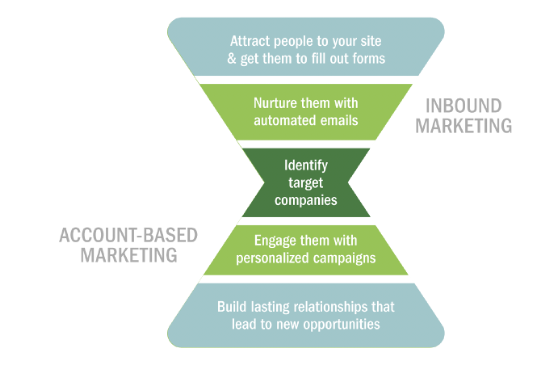
Picture a marketing funnel. The process goes from attracting to nurturing and then converting your collected leads.
But what if you flipped that funnel on its head? First, identifying leads that have a higher interest – and a higher likelihood of closing on your product – and then sharing engaging and personal information that applies to their need(s). This is account-based marketing (ABM).
In short, ABM is a focused growth strategy in which marketing and sales collaborate to create a personalized buying experience for a mutually-identified set of high-value accounts (HubSpot).
Think of it like this: inbound develops the foundation (attract and nurture) but then, instead of a standard close, ABM tailors all remaining communications to that specific client. So now, your marketing funnel looks something like this:

But what exactly does this all mean? 2020 in itself has shifted the buyer journey from industry events/trade shows and in-person meetings to everything operating in a virtual space. This shift, while necessary, can cause fatigue for your clients. Plus, they want a personalized and relvant experience to guide their decision making. Now, ABM has been a concept prior to this year, but it’s even more relevant as our clients navigate their own set of challenges:
- They want consumer information on-demand and on their terms.
- They desire a trusted buyer/seller relationship to reduce purchase risk.
- And most importantly, they have multiple decision-makers internally they have to align.
Tackling this multi-buyer decision-making process isn’t necessarily an easy one. But by implementing a two-way bridge of communication between your team and theirs (often including your lead consultant, the decision maker, an internal champion, committee and a subject-matter expert – woah) is imperative. And it’s done through serving personalized content and information teeing up to your clients business objectives.
In fact, alignment strategy such as this can help businesses become 67% better at closing deals with their clients (Marketo and Reachforce). So, you may be wondering, how exactly can I start?
If you’re already operating in a space of inbound marketing, there’s a foolproof process for implementing a full ABM strategy:
- Identify accounts: Whether it’s an account you’ve been nurturing and haven’t gotten to bite or one that is your dream sale, put pen to paper and make a list.
- Find with a contact: Already have one? Even better! But if you don’t, use your resources – like LinkedIn – to see if you have connections to get your foot in the door.
- Develop insights: What is it about your product that can help push your ask through? You may already have content like whitepapers or key benefits, but what makes you different? Boil down your usual talking points in a way that your client will understand. Are they a classic car owner? Read up on articles and have an analogy on hand.
- Put a plan to action: Now that you know who you’re going to talk with, and what you’re going to say, how are you going to do it? A direct mailer, a LinkedIn message or how about an email through your CRM?
- Execute content and messaging: Once you select your vehicle of communication, put together the content. Remember, this isn’t a cut and paste of your canned materials. Yes, hit on points of differentiation, but ABM is really about tailoring it to the customer. Not a mass email.
- Send and determine frequency: Yay, you did it! Now, how often do you plan to follow up with your contact?
- Measure and optimize for the future: What worked or what didn’t work? Is there anything that you can change for your next outreach that could put the sales process over the edge?
Today, as we’re living in a global pandemic, ABM is even more relevant. As you and your contacts are working from home, they are facing more distractions and are actually facing more multi-level decisions than they were at the comfort of their office desk. And as we look to planning for 2021, it’s likely that budgets, goals and objectives, and analysis of ever-changing priorities will continue.
And while we are continuing this work-from-home reality, take time to brush up on new ways of thinking and doing. This year has allowed efficiencies and growth in many ways, why not add ABM to your running list.




3 Comments